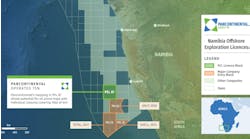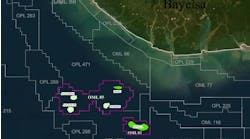Offshore staff
DUBLIN, Ireland – Providence Resources has provided a technical/resource update on Irish licensing option 11/9, which contains the Lower Cretaceous Drombeg prospect.
The company and partner Sosina Exploration were awarded the concession under the2011 Irish Atlantic Margin licensing round.
Drombeg is in 2,500 m (8,202 ft) of water in the southern Porcupine basin, about 220 km (137 mi) offshore West Cork, and 60 km (37 mi) from the ExxonMobil-operated Dunquin exploration prospect. Dunquin is due to be drilled in 2013.
Earlier this year, Ikon Science performed initial rock physics modeling and seismic inversion work over various 2D Drombeg seismic lines which exhibited a marked seismic anomaly. The study modeled the anomaly to be consistent with the presence of thick hydrocarbon-bearing sandstone intervals.
Analysis of the anomaly indicates recoverable P50 prospective resources of 872 MMbbl out of in-place oil of 2.97 Bbbl. However, further 3D seismic will be needed for a more definitive assessment.
Other similar Lower Cretaceous seismic anomalies have been identified both laterally offset to, as well as vertically stacked with Drombeg.
Additionally, two separate stratigraphic but vertically stacked objectives have been identified in the overlying Lower Cenozoic and underlying Upper Jurassic. The Lower Cenozoic feature could comprise a deepwater basin floor fan extending more than 295 sq km (114 sq mi) marked amplitude versus offset (AVO) anomaly.
The deeper Upper Jurassic feature is mapped as a large tilted fault block structure with about 140 sq km (54 sq mi). Providence has interpreted a fluid escape at the crest of the fault block which seems to be acting as a hydrocarbon migration path into both the overlying Drombeg Lower Cretaceous and Lower Cenozoic target intervals.
This fluid escape feature suggests an oil remigration model similar to that interpreted for BP’s Foinaven and Schiehallion fields west of Shetland in the UK sector.
John O’Sullivan, technical director of Providence, said: “Recent successful discoveries, both in West Africa and South America, have highlighted the enormous potential of the Lower Cretaceous deepwater clastic exploration plays of the central Atlantic. We believe that the results of the Drombeg seismic inversion signal that this significant play may well extend into the North Atlantic Conjugate Margin and, more particularly, into the southern Porcupine basin.”
11/12/2012


